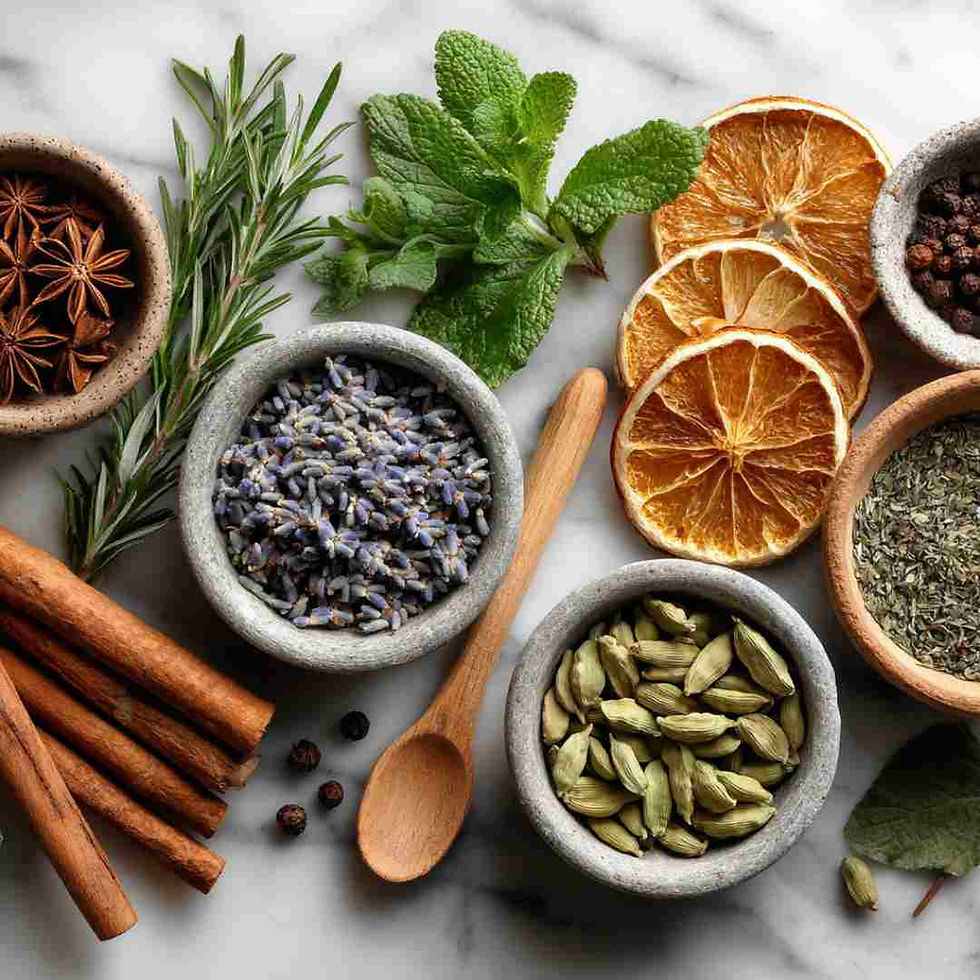The Art of Pairing Herbs and Spices: A Beginner’s Guide to Balancing Flavours
- Astrid van Essen
- Oct 13
- 3 min read
Updated: Oct 31
I use herbs and spices in everything — not just cooking. From teas and simmer pots to home remedies, they’re at the heart of how I bring warmth, balance and natural fragrance into everyday life. But if you’ve ever wondered why certain flavours work beautifully together while others clash, it all comes down to pairing.
Once you understand the basics of balance, you can confidently start pairing herbs and spices and creating your own blends.

You might also like to explore my sister site, Simmer & Stir — it’s where I share natural home fragrance ideas inspired by the same herbs and spices I use here on Botanical Blueprint. From simmer pot blends to herbal wax tablets, it’s all about bringing scent, warmth, and a touch of nature into your home through slow, sensory rituals.
Understanding Flavour Balance
Flavour pairing is about harmony. Every herb or spice has its own character: warm, cool, earthy, sweet, floral, or spicy. The goal is to combine them in a way that creates depth rather than competition.
Warm spices like cinnamon, nutmeg and cardamom bring comfort and sweetness.
Earthy herbs such as sage, thyme and bay leaf add grounding, savoury notes.
Fresh or cool herbs, such as mint, basil, and lemon balm, lift and brighten.
Citrus and floral notes, such as lemon zest or lavender, add a refreshing, aromatic layer.
When you balance these profiles, you create blends that are naturally more rounded and complex.
Classic Herb and Spice Pairings That Work Every Time
Here are a few timeless combinations you can use in both your kitchen and home fragrance blends:
Cinnamon + Clove + Orange Peel — warm, festive, and gently sweet.
Rosemary + Lemon Zest + Black Pepper — crisp and cleansing, perfect for winter air.
Lavender + Vanilla + Cardamom — floral with a hint of spice, calming and elegant.
Thyme + Bay Leaf + Garlic — classic savoury blend that brings depth to soups and stews.
Mint + Ginger + Lime — cooling yet energising, wonderful in teas or diffusers.
Start simple, then experiment by adjusting the strength of each note until you find your own perfect balance.
How to Create Your Own Blends
Choose your base note: This is the anchor of your blend, typically earthy or woody (such as cinnamon or sage).
Add a middle note: Something softer or floral to round out the base (such as lavender or cardamom).
Finish with a top note: A bright or citrus element to lift the scent or flavour (like lemon or mint).
Test and adjust: Even small changes can make a big difference. A pinch more citrus or a touch of spice can transform the result.
This approach works whether you’re seasoning food, crafting a simmer pot, or blending essential oils.
Quick Pairing Tip Chart
Herb or Spice | Flavour Profile | Works Well With |
Cinnamon | Warm, sweet | Clove, orange, vanilla |
Rosemary | Earthy, aromatic | Lemon, thyme, pepper |
Lavender | Floral, soothing | Vanilla, honey, citrus |
Sage | Savoury, earthy | Lemon, garlic, rosemary |
Mint | Cool, refreshing | Lime, basil, ginger |
Cardamom | Spicy, sweet | Cinnamon, coffee, rose |
Final Thoughts
The beauty of working with herbs and spices is that they’re endlessly versatile. You can create blends that evoke different moods, soothing, uplifting, or energising, simply by adjusting your combinations. Once you get the feel for balance, your kitchen and home will smell (and taste) richer than ever.
The Art of Pairing Herbs and Spices: FAQs
1. How can I tell if two spices will go well together?
Start by thinking about balance. Pair something warm with something fresh, or something sweet with something earthy. If the scent combination smells pleasant to you, it usually translates well into flavour as well.
2. What’s the difference between herbs and spices?
Herbs are the leafy green parts of a plant, while spices come from seeds, bark, roots or fruit. For example, basil is a herb, and cinnamon is a spice.
3. Can I mix dried and fresh herbs in the same blend?
Yes, but be aware that dried herbs are more concentrated. Use smaller amounts of dried herbs compared to fresh to avoid overpowering the blend.
4. How should I store herbs and spices to keep them fresh?
Store them in airtight glass jars, away from heat, moisture, and direct sunlight. Whole spices stay fresher longer than ground ones.
5. What are some easy blends for beginners to try?
Try cinnamon + clove + orange for a cosy scent, or rosemary + lemon + thyme for something refreshing and clean. Both work beautifully in cooking or simmer pots.



Comments